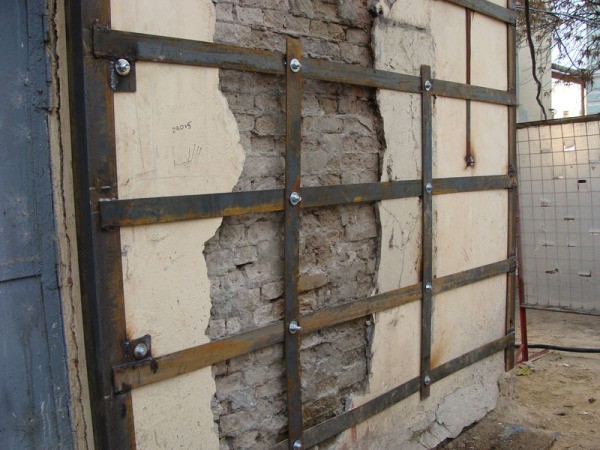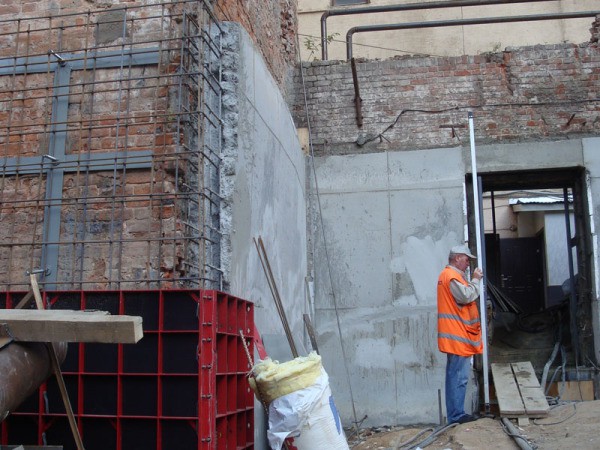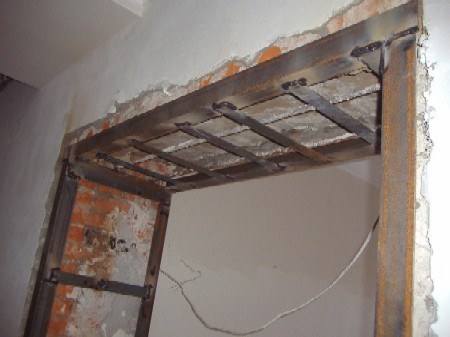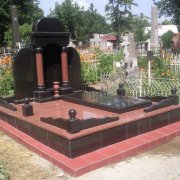Brick wall reinforcement technology: doing it right
Reinforcement of brick walls allows to increase their operational characteristics. Very often, cracks in the walls of a brick house can be seen, which indicates their weakness and the presence of a poor bearing support. There are various methods of reinforcing brick walls, allowing to increase their resistance. An article will tell about some of them.
The content of the article
What causes wall reinforcement
The basis for strengthening brick walls is their deformation, the reasons for which may be:
- Design errors. These include:
- insufficient foundation depth;
- unevenness when settling parts of the house;
- deformations arising in the beam coating;
- mismatch of the bearing capacity of the structure and the load on it.
- Exploitation. In this case, possibly happened:
- waterlogging styling;
- subsidence of the foundation.
- Errors that occurred when laying walls.
Assessment of the degree of damage to brick walls, by the loss of load-bearing capacity by elements, can be:
Weak - up to 15%. Due to:
- defrosting;
- wind load;
- damage to the wall material from fire to a depth of 5 millimeters;
- oblique and vertical cracks intersecting in no more than two rows of masonry.
Average - up to 25%. Called:
- weathering and thawing masonry;
- peeling of the facing material to a thickness of up to 25%;
- damage to bricks from fire to a depth of two centimeters;
- oblique and vertical cracks that intersect up to four rows of masonry;
- bulging and tilting walls on one floor, not exceeding a fifth of the thickness of the structure;
- the formation of cracks at the intersection of the transverse and longitudinal walls caused by a violation of the masonry of the lintels and under the supports of the beams;
- displacement of up to two centimeters of floor slabs.
High - up to 50%. This may be due to:
- collapse of the walls;
- masonry weathering and thawing up to 40% of its thickness;
- damage to the wall material from fire to a depth of 6 centimeters:
- oblique and vertical cracks, with the exception of temperature and sedimentary cracks, to a height of 7 rows of masonry;
- bulging and tilting walls on one floor by one percent of its height;
- displacements of racks and walls along an oblique ridge or horizontal joints;
- separation of longitudinal walls from transverse;
- damage to masonry under the racks of beams and lintels with a depth of more than 2 centimeters;
- displacements of floor slabs on supports more than 4 centimeters.
Tip: Walls that have lost more than 50% strength should be considered destroyed. The presence of the above damage is the basis to carry out repair work.
How to strengthen brick walls
Repair and subsequent strengthening of brick walls, schemes for its implementation can be very different, but in any case it is necessary:
- Repair the basement of the building.
- Close up cracks.
- Repair and strengthen the jumpers.
- Reinforce individual piers and racks.
- Provide spatial rigidity of the walls.
- Perform relocation on separate sections of the walls.
- Insulate walls.
- To lay or arrange openings.
- Strengthen wall masonry by injection.
In brick houses, cracks can be:
- Narrow - 5 millimeters. Such defects are necessary:
- to embroider;
- rinse with water;
- masonry shotcrete.
- Wide - up to 40 millimeters that do not violate the integrity of the masonry. Close up in the same sequence as narrow cracks.
- More than 4 centimeters violate the integrity of the masonry. In this case, the crack:
- cleared;
- washed with water;
- is choked with shotcrete;
- holes are drilled along the length of the crack;
- injectors are inserted into the holes;
- a special solution is pumped into the cavity of the crack under pressure.
In the diagram:
- 1 - crack in the masonry.
- 2 - installation of injection holes.
- 3 - nozzles for injection.
- 4 - a solution of cement and sand.
Silicate brick walls can be strengthened in such ways as:
- The use of clips from reinforced solutions.
- Reinforcement of brick walls with steel bands.
- The device of reinforced concrete clips around the perimeter of the building.
- The use of composite materials for clips.
- Reinforcement of brick walls with steel clips.
When choosing a method of enhancing a house, a large number of factors should be considered.
It can be:
- The brand used for plaster, concrete or mortar.
- Percentage of building reinforcement.
- The condition of the masonry wall.
- Load diagram for the entire building.
The strength of the brickwork depends directly on the percentage of reinforcement with clamps.
With an external examination, you can evaluate:
- The number of cracks.
- Their sizes: depth and width.
Tip: To restore the strength of the bearing walls of a lady with cracks, it is necessary to reinforce them with clips.
How to make a reinforced clip
You can repair cracks and prevent the appearance of new defects with your own hands by reinforcing the walls (seeReinforced belt on load-bearing walls according to all the rules).
To do this, use:
- Reinforcing cages.
- Reinforcing bars
- Reinforcing mesh.
- Reinforced concrete pilasters.
Instructions for reinforcing the wall with reinforcing mesh suggests:
- You can install the material on one or both sides, fixing the grid on the repaired area.
- Pre-drilled holes.
- The mesh is fastened through studs or anchor bolts included in these holes.
- Cement mortar is applied, not lower than grade M100.
- A layer of plaster is applied with a thickness of 2 to 4 centimeters.
- Auxiliary rods are attached with a diameter of 6 millimeters, along the height of the corners, lowering the elements by about 30 centimeters to ensure their reinforcement.
- With one-sided fastening, anchor nets with a diameter of 8 mm are placed in increments of up to 80 centimeters.
- When the grid is placed on both sides, it is fastened with through anchors with a diameter of 12 millimeters in increments of up to 1.2 meters, welding or fasteners to metal grids.
How to install a reinforced concrete belt
A silicate brick wall can be reinforced with a reinforced concrete belt.
Its advantages:
- Time saving.
- Lower price.
Disadvantage:
- The load on the foundation is increasing.
When using a reinforced concrete cage, such technical characteristics as:
- The thickness of the manufacturing structure from 4 to 12 centimeters.
- The concrete mix is selected with fine grain of at least grade 10.
- Transverse reinforcement is selected A240 / AI class, with installation steps up to 15 centimeters.
- Longitudinal reinforcement is taken A240-A400 / AI, AII, AIII class.
To make a structure from a reinforced concrete “shirt”, it is necessary to install a reinforcing mesh around the entire perimeter, fixing it not with masonry clips.
Tip: To strengthen a brick wall, create a shell that exceeds the strength of the wall by several times.
The performance indicators of the clip are:
- The condition of the laid surface.
- Concrete strength.
- The nature of the load.
- The percentage of reinforcement.
This type of construction takes part of the load, freeing the masonry.
In the manufacture of clips:
- Layers up to 4 centimeters thick are made by pneumatic concrete and shotcrete, and then plastering is performed.
- If the layers have a thickness of up to 12 centimeters, the wall holder is made using inventory formwork mounted around the reinforced base. Inventory formwork is installed along the entire height of the reinforced structure to protect the reinforcing layer. In the formwork injection tubes are arranged, and a fine-grained concrete mixture is fed into them.
Features of the composite clip
The photo shows the construction of a clip made of composite materials. This is one of the most effective methods for reinforcing brick walls through the use of high-strength fibers: coal and fiberglass.
They allow you to increase strength:
- To compress sheer structures.
- To shear or slice perpendicular sections.
Work technology:
- Prepared masonry is treated by impregnation.
- A primer is applied to harden the surface.
- Metal frames are installed.
- Disassemble temporary fasteners.
Tip: The gaps should be removed after 50% of the strength has been set with a new masonry, the value of which is indicated in the design.
- Piers are painted and plastered.
How to make a steel structure
Mounting a steel sleeve significantly increases the load-bearing capacity of the building.
To make it, you must purchase:
- Reinforcing bars with a diameter of 12 millimeters.
- Cross metal strips, section up to 6 centimeters wide, up to 12 millimeters thick.
- Profile corners.
Further:
- On the solution in the corners of the area intended for amplification, vertical corners are set.
- Streaks are fastened in increments of not more than 50 centimeters.
- The longitudinal angles are selected with a length equal to the height of the reinforced structure.
- A metal mesh is applied to the corners to improve the structural strength.
- Cement mortar should be up to 3 centimeters thick to protect the metal from corrosion.
Tip: When finishing a large area, the process must be performed using a mortar pump.
What modern methods are used to improve the strength of brick walls
Traditional methods using composite materials and injection, which quickly and efficiently strengthen brick walls, can replace innovative methods of carrying out the process.
Its essence is as follows:
- Holes are drilled in the body of the building structure.
- Repair compounds are pumped into them under pressure, which can be:
- microcements;
- on epoxy;
- on a polyurethane basis.
- The injection mixture fills the existing voids of the building structure, the existing cracks, which prevents the destruction of the wall and provides reliable waterproofing of the building.
Injecting walls allows you to:
- Fully strengthen the brickwork.
- Perform structural bonding of the material.
- Protect walls from the harmful effects of capillary moisture.
When reinforced with composite materials:
- Canvases (tapes or nets) of high-strength material made from fiberglass or carbon are glued to the building structure.
- The adhesive may be cement or epoxy based formulations.
Reinforcement of masonry, reinforcement of openings in brick walls should be completely performed in order to restore absolutely all damaged areas. It is very important to carry out the reconstruction of the house in a timely manner in order to prevent the complete destruction of the walls. Any method, if properly executed, strengthens the brickwork, increases the building's resistance to stresses, existing deformations and other factors. All the features of the work shows the video in this article.











